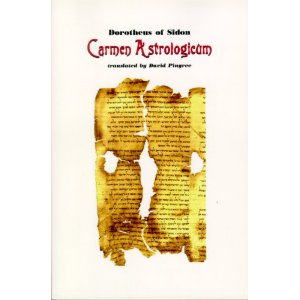
This 2000-year old text by Dorotheus of Sidon presents a survey of Hellenic astrological techniques. Written before Ptolemy’s Tetrabiblos, Dorotheus (who probably practiced in Alexandria) gives diverse techniques for natal chart interpretation, along with some sample charts. Although modern astrologers are used to seeing charts printed along with text, it’s an eye-popper to see charts with dates from 12 AD to 36 AD! The charts are reproduced in their original format, too: squares with the ascending sign at the top and the Midheaven at the right. Planet names are written rather than shown as glyphs.
Dorotheus’ interpretations rely on the placement and aspect relationships of triplicity rulers as judged in diurnal and nocturnal charts. The Egyptian triplicity rulers are used (this is slightly different than the Greek set). The moon’s phase and speed are important considerations.
Much information is provided on judging a client’s upbringing, his finances, marriage, children, health, etc. Lots or Parts are offered as supplemental indicators (but the calculation method is flawed, possibly copy errors). There is a long analysis on slavery, suggesting the Dorotheus served enslaved clients fairly regularly, as he is quite able to give advice on judging whether one will remain a slave, escape or be manumitted (freed).
This is followed by a section on interrogations (elections). Some of the election topics are a bit odd. In one section, “The courtship of a woman, and what occurs between a wife and her husband when she quarrels and scolds and departs from her house publicly,” Dorotheus gives advice about judging in the chart whether the woman will come back or not, and if she returns, if she will be happy or hold her grudge. Other topics include choosing marriage partners, and the best time to pay debts, build and launch boats, buy livestock, pursue lawsuits and even exorcisms. Instructions for reading decumbiture charts (cast at the time a sick person takes to his bed) are included. The Moon determines recovery or death, a long or a short illness. There are methods for analyzing whether the patient gets a good or bad doctor, and whether the medicine will work or not.
David Pingree does a readable translation but doesn’t supplement with footnotes. Unfamiliar techniques and phrases are not explained. When forecasting is discussed, it’s not clear if the author is referring to solar returns or profections. Dorotheus assumes the reader already knows how to cast a chart and the meanings of the signs and planets.
The sample charts suffered from either bad calculations or copyist errors over the centuries, too. These are some of the earliest known charts and have immense historic value. Computer-generated charts are given in the Appendix using chart data selected by Pingree based on the surviving Arabic versions of the text. In a similar appendix in The Judgment of Nativities by Abû ‘Ali Al-Khayyat translator James Herschel Holden questions the accuracy of Pingree’s chart rectifications and offers alternate birth data that fits the chart interpretations better. (AFA , 2008, pp 111-119.) Al-Khayyat was a 9th century Arabic astrologer with similar techniques, and he borrowed some of the charts from Dorotheus’ text for his own book. Holden’s footnotes and remarks are quite valuable, and this book is suggested for reading before one examines the Carmen Astrologicum.
This is a lengthy text for the time period, and its omission of basic astrology is fairly unusual. This manuscript was written for intermediate and practicing astrologers who were consulting with clients. Of course, only the seven visible planets are used; the Part of Fortune and other parts (oddly, they aren’t utilized in the sample charts). Dorotheus makes use of the Hyleg (here spelled “haylaj”) and Nodes, but doesn’t mention them much. The planets are called “stars” and the houses can be referred to as “the place.” Angular houses are “tropical” or “cardine.” The reader must adjust to the terminology.
I would not recommend this as a first ancient translation to acquire, however; Holden’s translation of Rhetorius the Egyptian is a real goldmine. A new translation of Vettius Valens (who is mentioned and quoted in the Carmen Astrologicum) will be available soon, and covers the similar ground with more assistance given to the reader in the form of footnotes and appendices. Readers would also benefit from reading contemporary explanations of Hellenic astrology by Joseph Crane or Lee Leighman before delving into ancient texts. This book will be more easily digested by readers who have done preparatory reading on Hellenic astrology.
This is a valuable text on a number of levels: pre-Ptolemy, Hellenic-Egyptian origin, an extensive manual for intermediate and professional astrologers, and sample charts. Dorotheus was a man who obviously worked with a lot of clients. He knows his stuff, and sets about explaining his methods without any fussing around and covers an immense array of techniques in his book.
~review by Elizabeth Hazel
Author: Dorotheus of Sidon. Translation by David Pingree.
Astrology Classics, an imprint of the Astrology Center of America (www.astroamerica.com), © 1976; with additional notes by Dorian Gieseler Greenbaum © 2005.
$21.95
